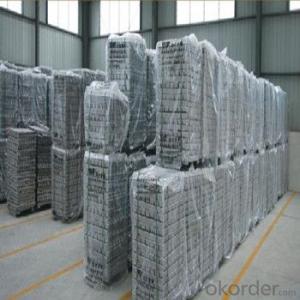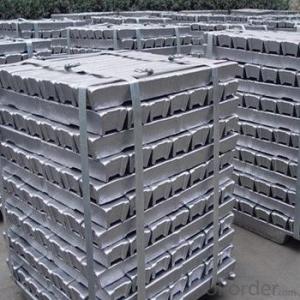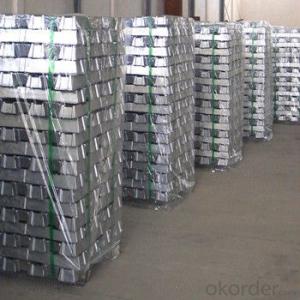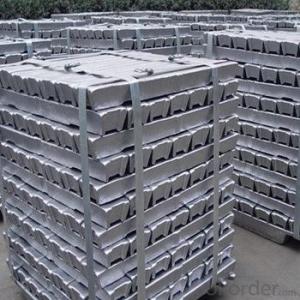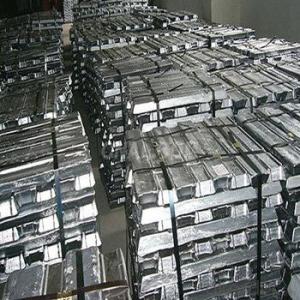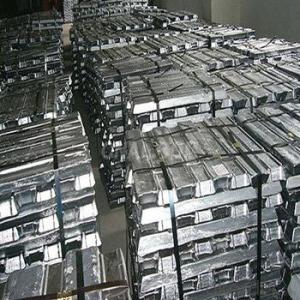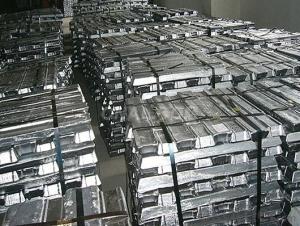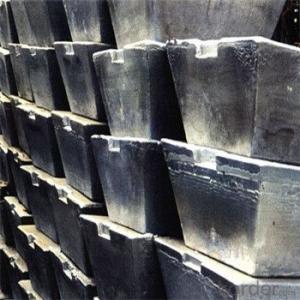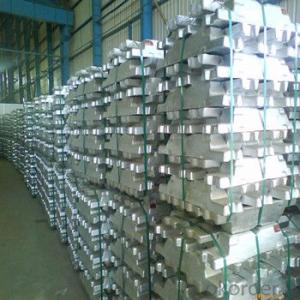Aluminum Pig/Ingot Sold With Wholesale By Mills
- Loading Port:
- China main port
- Payment Terms:
- TT OR LC
- Min Order Qty:
- 1000 m.t.
- Supply Capability:
- 100000 m.t./month
OKorder Service Pledge
OKorder Financial Service
You Might Also Like
Pure Aluminum Pig/Ingot Used for Industry
1.Structure of Aluminum Pig/Ingot
A material that has been cast into a shape in order to be transported and processed easier than in an unprocessed form. An ingot is typically rectangular in shape, which allows it to be stacked. Ingots are most commonly associated with metals, with ingots of gold held in the vaults of banks and brokerages being popular images.
Aluminum Ingot is with the AL as the main chemical composition.Aluminum Ingot is used for industry,such as automobile,pinning and weaving,electron broadly and so on. Aluminum Ingot has the following advantages: easy control and operation, fast melting.
2.Main Features of the Aluminum Pig/Ingot
•High Purity
•Easy control and operation
•High strength
•Fast melting
•Competitive price
•Best Service
3.Aluminum Pig/Ingot Images


4.Aluminum Pig/Ingot Specification
Grade | Chemical Composition % | |||||||||
Al≥ | impurities ≤ | |||||||||
Si | Fe | Cu | Ga | Mg | Zn | Mn | others | Sum | ||
Al99.9 | 99.90 | 0.50 | 0.07 | 0.005 | 0.02 | 0.01 | 0.025 | - | 0.010 | 0.10 |
Al99.85 | 99.85 | 0.80 | 0.12 | 0.005 | 0.03 | 0.02 | 0.030 | - | 0.015 | 0.15 |
Al99.7 | 99.70 | 0.10 | 0.20 | 0.010 | 0.03 | 0.02 | 0.030 | - | 0.030 | 0.30 |
Al99.6 | 99.60 | 0.16 | 0.25 | 0.010 | 0.03 | 0.03 | 0.030 | - | 0.030 | 0.40 |
Al99.5 | 99.50 | 0.22 | 0.30 | 0.020 | 0.03 | 0.05 | 0.050 | - | 0.030 | 0.50 |
Al99.00 | 99.00 | 0.42 | 0.50 | 0.020 | 0.03 | 0.05 | 0.050 | - | 0.050 | 1.00 |
5.FAQ of Aluminum Pig/Ingot
We have organized several common questions for our clients,may help you sincerely:
①How about your company?
A professional factory which foucs on producing the aluminum pig,can meet customers' requiement to the quality and grade.The quality also have been accepted by customer.Already got the good reputation among the customers.It have gotten lot of much experience.The facrtory has the professional Technical Worker and the advanced equipments for production.Beside,it has the profesional teams to operate the whole proess for exporting.OEM service is availble and welcome.The items have beedn exported around the world,and have been acceptable among the customers,and have gotten the good reputation already.No matter from the quality,price and service,can be guaranteed for the cusgtomers.High purity and diffent grade are available.
②How to guarantee the quality of the products?
We have established the international advanced quality management system,every link from raw material to final product we have strict quality test;We resolutely put an end to unqualified products flowing into the market. At the same time, we will provide necessary follow-up service assurance.
③How long can we receive the prod rking days, We will arrange the factory delivery as soon as possible. The pecific time of receiving is related to the state and position of customers.Commonly 7 to 10 working days can be served.
- Q:How are aluminum ingots used in the production of railway components?
- Due to their unique properties and benefits, aluminum ingots play a crucial role in the production of railway components. They are melted down and serve as raw material for manufacturing various railway parts. One major use of aluminum ingots in railway components is seen in the construction of lightweight yet durable train bodies. The high strength-to-weight ratio of aluminum makes it an ideal material for building train carriages and panels. By utilizing aluminum ingots, manufacturers can create lightweight structures that are easier to transport and require less energy to operate. This not only reduces fuel consumption but also contributes to a more sustainable and eco-friendly transportation system. Furthermore, aluminum ingots are utilized in producing other railway components like doors, windows, and flooring. These components need to possess strength, resistance to corrosion, and the ability to withstand harsh environmental conditions encountered in railway operations. Aluminum, being highly resistant to corrosion, offers exceptional protection against weathering, ensuring the longevity and reliability of these components. In addition, aluminum ingots find application in the production of electrical components for railways. Aluminum's excellent electrical conductivity makes it suitable for manufacturing overhead power lines, conductor rails, and electrical connectors. These components are vital for ensuring efficient power transmission and distribution throughout the railway system. To conclude, aluminum ingots are vital for the production of railway components. Their lightweight nature, strength, corrosion resistance, and electrical conductivity make them ideal for manufacturing train bodies, doors, windows, flooring, and electrical components. By utilizing aluminum ingots, the railway industry can achieve improved efficiency, durability, and sustainability in their operations.
- Q:What are the different surface coatings for aluminum ingots?
- There are several different surface coatings that can be applied to aluminum ingots, each serving a specific purpose. The most common coating is anodizing, which involves creating a protective oxide layer on the surface of the aluminum through an electrochemical process. Anodized aluminum offers increased corrosion resistance, improved durability, and can be dyed in various colors. Another coating option is powder coating, which involves applying a dry powder to the surface of the aluminum and then curing it under heat to form a hard, protective layer. Powder coating provides excellent resistance to abrasion, impact, and chemicals, and it can be applied in a wide range of colors and finishes. For applications requiring enhanced lubricity or low friction, a Teflon or PTFE (polytetrafluoroethylene) coating can be used. This coating reduces friction and wear, improves release properties, and provides excellent chemical resistance. In some cases, aluminum ingots may also be coated with a thin layer of zinc through a process called galvanization. This zinc coating offers protection against corrosion and can be further enhanced by applying a powder coating or paint on top. Additionally, aluminum ingots can be coated with various organic coatings, such as acrylic, epoxy, or polyurethane, to provide a decorative finish or to protect against environmental factors like UV radiation or moisture. Overall, the choice of surface coating for aluminum ingots depends on the specific application requirements, such as corrosion resistance, durability, friction reduction, or aesthetic appeal.
- Q:What are the main factors influencing the choice between aluminum ingots and aluminum wires?
- The choice between aluminum ingots and aluminum wires is determined by several key factors: intended use, cost, and convenience. To begin with, the intended use of the aluminum product plays a significant role in determining whether ingots or wires are more suitable. In manufacturing processes, aluminum ingots are commonly used as raw materials that can be melted and cast into various shapes like sheets, bars, or profiles. They find applications in industries such as construction, automotive, and aerospace. On the other hand, aluminum wires are primarily used for electrical purposes like wiring systems, power transmission, and electrical components. Hence, the specific purpose of the aluminum product needed greatly influences the choice between ingots and wires. Moreover, cost is an important factor to consider. Aluminum ingots generally have a lower cost compared to aluminum wires. This is because ingots are the basic form of aluminum and require additional processing to become wires, involving extra manufacturing steps and costs. However, it is crucial to take into account the overall project requirements. Using aluminum wires directly may save costs associated with additional processing and labor. Lastly, convenience also plays a role in the decision-making process. Aluminum wires are readily available in the market, and they come in various sizes and specifications, making them easy to purchase. They are already in a usable form and can be directly installed or integrated into electrical systems. On the other hand, aluminum ingots may need further processing, such as melting, casting, and shaping, before they can be used in a specific application. Therefore, if time and resources are limited, aluminum wires may be a more convenient choice. In conclusion, the choice between aluminum ingots and aluminum wires depends on the intended use, cost, and convenience factors. Understanding the project requirements, considering the associated costs, and evaluating the convenience of each option will help in making an informed decision.
- Q:Can aluminum ingots be used in medical applications?
- Yes, aluminum ingots can be used in certain medical applications. Aluminum is lightweight, non-toxic, and has excellent corrosion resistance, making it suitable for medical devices such as orthopedic implants, prosthetics, and surgical instruments. However, it is important to note that aluminum should meet specific medical grade standards to ensure its safety and compatibility with biological systems.
- Q:How to refine aluminum ingot
- As for the procedures, just started, can not do not do, not encourage illegal business, but then you should make the cash flow on the blade, so you have to consider your experience to set up the factory scale, and then targeted the related formalities, in fact you know some of the company law and policy development and Reform Commission, there will be a natural answer. Your own understanding of the industry is the most important.
- Q:What kind of material is die casting aluminium ingot?
- Aluminum, our daily industrial material called aluminum ingots, according to the national standard (GB/T1196-93) should be called "remelting aluminum ingot", but we call "ingot". It is used in alumina cryolite produced by electrolysis.
- Q:REGAL-S33N what is the aluminum ingot material?
- Aluminum, our daily industrial raw materials called aluminum ingot, according to the national standard (GB/T1196-93) should be called "remelting with aluminum ingot", but we are used to "aluminum ingot"". It is with the alumina cryolite produced by electrolysis.
- Q:Can aluminum ingots be anodized?
- Yes, aluminum ingots can be anodized. Anodizing is a process that involves creating an oxide layer on the surface of aluminum, which can be done on both raw aluminum and aluminum alloys. This process enhances the metal's corrosion resistance, improves its appearance, and allows for coloring or dyeing options.
- Q:How can I make a pop top aluminum ingot?
- Production of miscellaneous aluminium ingots by mixing with other waste aluminum;A deoxidizer used in steelmaking;Production of aluminum: the waste cans in the rotary kiln for stripping paint processing, and then processing, production of low-grade aluminum powder.
- Q:How can the sustainability practices in aluminum ingot production be enhanced?
- There are several ways in which the sustainability practices in aluminum ingot production can be enhanced. Firstly, the adoption of cleaner and more energy-efficient technologies can greatly reduce the environmental impact of the production process. This could involve the use of renewable energy sources, such as solar or wind power, to power the production facilities. Upgrading equipment and machinery to more energy-efficient models can also help minimize energy consumption and reduce greenhouse gas emissions. Secondly, optimizing the recycling and reuse of aluminum scrap and waste materials can significantly reduce the need for virgin aluminum production. Implementing effective recycling programs and investing in advanced recycling technologies can ensure that a higher percentage of aluminum is recovered from end-of-life products and incorporated back into the production process. This not only conserves valuable resources but also reduces the energy-intensive extraction and refining processes associated with primary aluminum production. Thirdly, improving water management practices can contribute to enhanced sustainability in aluminum ingot production. Implementing efficient water conservation measures, such as recycling and reusing water within the production process, can help minimize water consumption. Additionally, implementing wastewater treatment systems to remove pollutants and contaminants from the discharged water can prevent water pollution and protect local ecosystems. Furthermore, promoting transparency and responsible sourcing practices in the supply chain can enhance sustainability in aluminum ingot production. This includes ensuring that the raw materials used in the production process, such as bauxite and alumina, are sourced from responsible and sustainable mining practices. Implementing traceability systems and certification programs can help verify the origin and sustainability of these materials, ensuring compliance with ethical and environmental standards. Lastly, engaging with stakeholders, including employees, local communities, and industry associations, can foster a culture of sustainability and drive continuous improvement in aluminum ingot production. This can involve regular training and awareness programs on sustainable practices, as well as collaborating with suppliers and customers to identify and implement innovative sustainability solutions. Overall, enhancing sustainability practices in aluminum ingot production requires a holistic approach that combines technological advancements, efficient resource management, responsible sourcing, and stakeholder engagement. By implementing these measures, the aluminum industry can minimize its environmental footprint and contribute to a more sustainable future.
1. Manufacturer Overview |
|
|---|---|
| Location | |
| Year Established | |
| Annual Output Value | |
| Main Markets | |
| Company Certifications | |
2. Manufacturer Certificates |
|
|---|---|
| a) Certification Name | |
| Range | |
| Reference | |
| Validity Period | |
3. Manufacturer Capability |
|
|---|---|
| a)Trade Capacity | |
| Nearest Port | |
| Export Percentage | |
| No.of Employees in Trade Department | |
| Language Spoken: | |
| b)Factory Information | |
| Factory Size: | |
| No. of Production Lines | |
| Contract Manufacturing | |
| Product Price Range | |
Send your message to us
Aluminum Pig/Ingot Sold With Wholesale By Mills
- Loading Port:
- China main port
- Payment Terms:
- TT OR LC
- Min Order Qty:
- 1000 m.t.
- Supply Capability:
- 100000 m.t./month
OKorder Service Pledge
OKorder Financial Service
Similar products
New products
Hot products
Hot Searches
